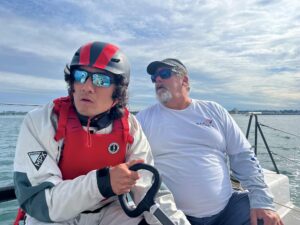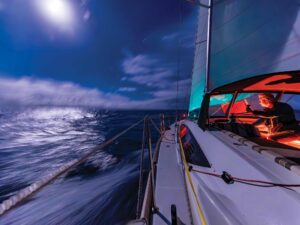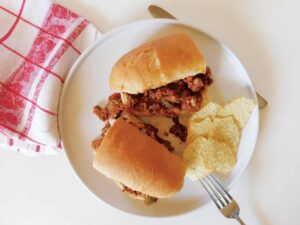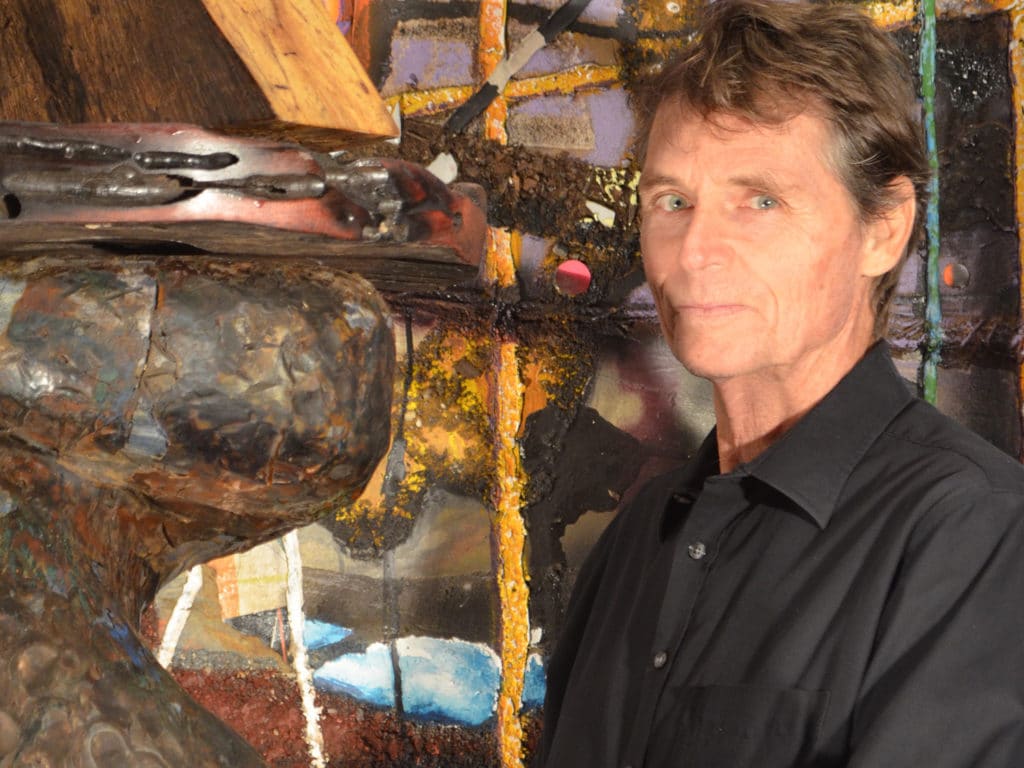
As the coronavirus continues to change and reshape the world as we know it, Cruising World is reaching out to contributors, our partners in the marine industry, and other sailors to get their take on where they are and how they’re doing. We’re asking five questions to each of them, and in this installment, we’re checking in on artist, adventurer and long-distance sailor Reid Stowe. Reid is perhaps best known for his record-setting voyage he called 1,000 Days at Sea: The Mars Ocean Odyssey, a journey that actually took 1,152 days at sea aboard his 70-foot schooner Anne from 2007 to 2010. In addition to the interview, Reid has supplied images of two of his latest works, with insights and descriptions about his technique and inspiration.
1. Reid, where are you now? How are you coping with these strange days? What are you working on?
When I completed the “Mars” voyage, my sailing partner Soanya, who gracefully completed the first 306 days consecutively at sea with me (before departing in Australia when she learned was pregnant) greeted me with our almost 2-year-old son, Darshen. A year after that we sailed down to the Essequibo River in Guyana for an adventure and to repair the schooner with beautiful woods and cheap local labor. Then Mom died. I knew Dad had Alzheimer’s, so we made the decision to sail home to his house in Greensboro, North Carolina, to take care of him. That’s where we are now. It has been a nice family time for all of us. I left the schooner tied to poles on the Cape Fear River and she has gone way downhill. We are not too sure what happens next as we are committed to Dad. The hull and motor are in great shape and because she is a homemade work boat, it won’t be too expensive to get her going again.
2. The Mars Ocean Odyssey, during which you spent 1,152 days at sea, unsupported, was one of the most remarkable—and isolated—voyages ever conducted. How did you prepare for such a journey, and were your preparations adequate for what you ultimately faced?
In 1986, before leaving for Antarctica on my first long trip aboard Anne, I decided to go “1,000 Days Non-Stop at Sea.” That made the Antarctic expedition a test. From then on, my life was about the 1,000-Day Voyage. Actually, I designed and built the schooner as the ultimate, long-distance, heavy-weather sailboat, with a big cargo hold to carry everything we needed. Every feature of the schooner was geared for an ultimate storm and the ability to make repairs while underway. So basically, I prepared for a lifetime on all levels on how to take a boat to sea and stay out there. I didn’t really care where I went; what I loved was being at sea.
The preparations were adequate, because I succeeded, and the first thing I said when I hit the dock was: I could have kept going for another year. I was strong and happy, all my systems were “go” and I had enough of every food, most importantly seeds for growing my fresh food sprouts. I only came back because my faithful partner Soanya has been waiting for me with our child. I would have prepared the schooner differently had I achieved a (sponsor and hefty) budget, so I had to leave with old sails and an old boat that was worn out. But I often think, put any number of great sailors on a multimillion-dollar boat. At sea, anything can happen. They would need a lot of luck and blessings to surpass my record.
3. We are all sheltering in place now, and in the process, learning new things about ourselves. What did you learn during your extended time alone, and what advice would you share with people who are now facing their own different versions of limited social contact and downright isolation?
What did I learn at sea? That’s a huge question. I have written all that down over the years. But yet with the help of New York literary agents and five New York Times stories under my belt, we have not been able to publish our mainstream story. I am still hoping that will open the way for my other books. We wrote a food book to share how we ate and stayed healthy. I compiled my writings and wrote a spiritual, how-to yoga book. Much of that can be geared to preparing people to evolve off the Earth on spaceships. It has surprised me that no one really wants to know how we did it. There are so many details. I have a lifetime of learning and writing to be an ultimate seaman, boat builder, schooner sailor, but I don’t think I will compile that into a book because I don’t think there is a big enough audience.
What I learned through my art is that in my art, there are huge teachings there and that is a subject I am working on. What I realized with my recent art shows in New York and Miami is people love my art and I got a lot of press, but people don’t understand my art any more than they do my voyage. Who can really begin to understand the voyage unless they have spent significant time at sea? The art empowered the voyage. It gave me vision and access to higher powers. And in turn, the voyage empowers the art. This is all new and evolved stuff. I will continue to share what I have learned throughout my life. (Thanks for giving me the opportunity!)
Advice to share on isolation: We have been asked to do some video interviews and podcasts that are up on the internet (check out Reid’s websites: www.reidstowepaintings.com and www.reidstoweart.com. The Russian version of Forbes just did a story on us. An art magazine is doing an isolation article on me now. We have continued to get press because our story is so encompassing of the human soul and its journey. We follow a structure when we discuss isolation so we can hit the main points. Here they are:
- Have a structure
- Pace yourself
- Go outside
- Do your hobby
- Keep a journal
- Take the time to connect with family and friends
- Listen to the experts
- Realize we are all connected
We kind of elaborate on these things, with our connected unity and oneness being the most important to remember. To choose isolation and carry it out positively is a wonderful opportunity. In the end, we will all be isolated on our journey into the unknown and it is important for people to prepare for that in the most glorious way.
4. What was it like returning to the bustle of “civilization” upon your return? Were you fundamentally changed by the experience? Did it affect your artistic creativity and inspiration going forward, in expected or unexpected (positive or negative) ways?
It was great to get back to Soanya, family and friends, and New York City, but the state park authorities would not let us stay on our home dock on West 23rd St. even though the owner wanted us there, so we had to leave New York. We didn’t have money. I had a choice of interested literary agents and others, but our story didn’t get picked up, so we did not have an income. I had spent the better part of my life cutting myself off from all things of the land, so I never really got my feet back on the ground. The schooner looked like the Flying Dutchman, so I had to keep improvising to survive. And that has not changed much. I sell a few paintings, but my break with the books, art and space-analogous voyage promotions has not come (to pass), but I keep trying. Look, it took me 21 years of trying before I was able to set off, but I succeeded with the impossible. I have a happy family life around me and I feel grateful. Having departed the touch of the earth/land longer than any human, I feel blessed and powerful, and still believe I have the potential to share what I have experienced and create in a big way.
5. What next? Is there another long voyage in your future?
Yes, we are working on developing a space analogous voyage with the Mars Society. We are caring for dad now and I imagine some good surprise will arrive to inspire our future.
Accompanying these Five Questions with Reid Stowe are two of his latest works, along with his thoughts:
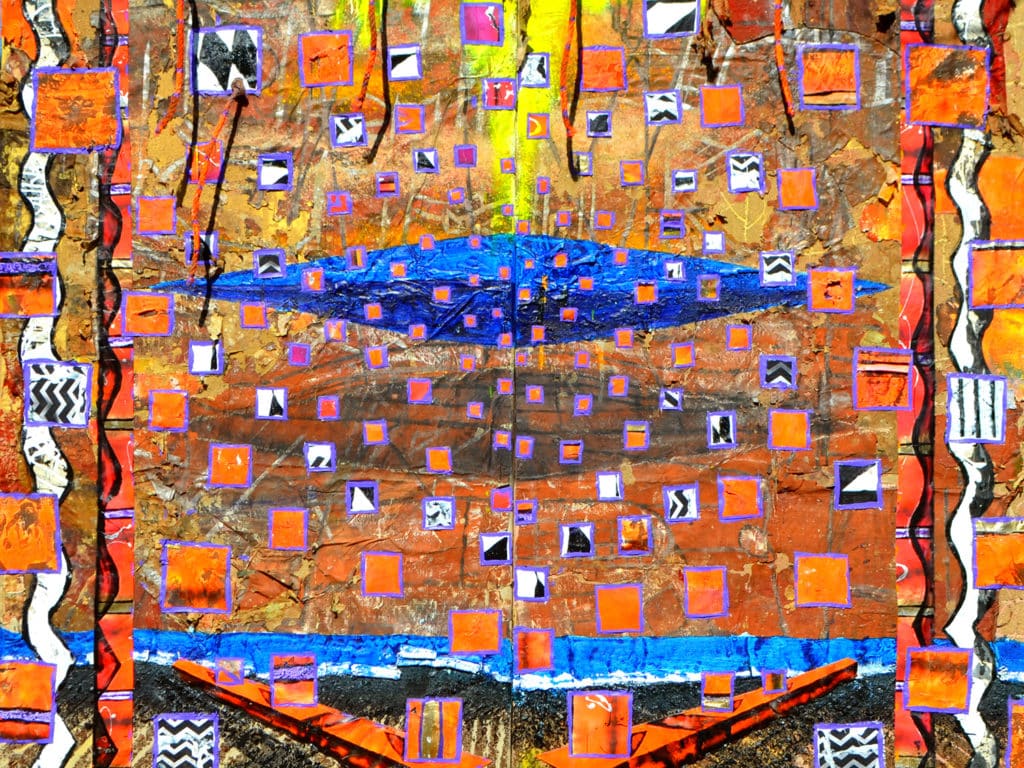
This “Mars Ocean Odyssey” painting is 8 by 8 feet, started in 1987 when I first coined the term “Mars Ocean Odyssey” for my space-analogous voyage, 1000 Days Non-Stop At Sea. The blue is our wish to add water to Mars. In 1987, I saw the need to make paintings for astronauts in the same way that I made magical paintings to help me with my voyaging. For example, in 1973, I painted my North Atlantic chart and drew a little picture of myself on the other side cheering, saying, “Hooray! I made it!” There is more to it, but after that, I firmly believed my art helped me do what I do. After a lifetime of innovative voyaging, ultimately the proof is that I succeeded accomplishing what no man dreamed of or thought possible. On my home-built schooner, I departed the touch of the earth/land far longer than any human, thus leading the evolution of mankind off of the earth.
By 1987, I was already using earth and natural aggregates in my paintings and I realized I would have to bring plenty of earth with me to keep me balanced during the voyage. I also realized that when astronauts went on a long voyage to Mars, they would also have to bring earth and other elements to actually feel, to keep them in touch with the Earth. Those elements and textures would give them something different than a polished, sterile spaceship to feel. I imagined that astronauts could give up the weight of a few desserts and take a small painting with a deep depth perspective that they could stare into and feel the gold, and the wood, and a small piece of one of my sails that had the salt of the world’s sea and the skin and oil from my fingertips and even the emotions that I felt in that life-and-death environment after not having seen land or another human for years. More importantly, as a shaman mystic, I saw that the mix of elements in the paintings for astronauts created an alchemical vibration that took the paintings into the fourth dimension, where they accessed universal energy that healed and purified me and prepared me for my space analogous voyage.
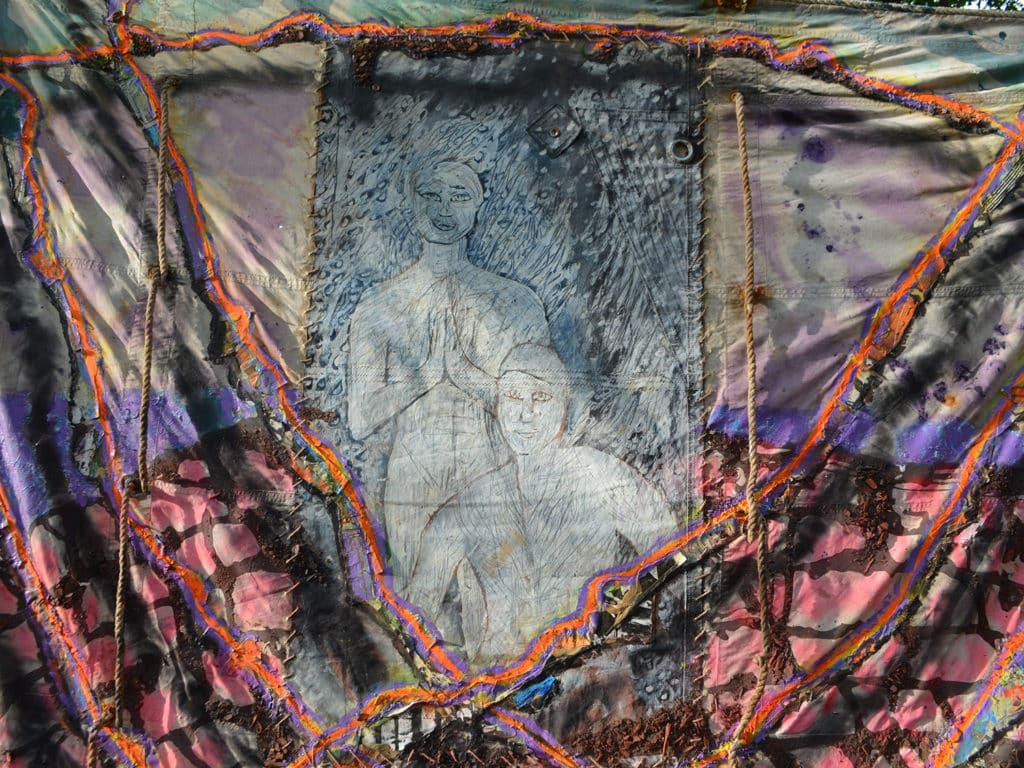
This work is 16 x 16 feet, painted on a sail. I title all my paintings so that I can remember them. I date them from when I start them until I think they are finished. Often I paint on them again even after I think they are finished. I have been painting all my life and it has always been an important part of my sailing. Even on my first voyage in 1973 on my 26-foot Wharram catamaran Tantra that only weighed 1,400 pounds, I brought my wood carving and painting supplies. I soon started painting on old sails because that was what became available for me to paint on. When I built my 70-foot, gaff-rig schooner Anne, I started painting on much larger sails that I usually got off of older sailing ships that I encountered in ports around the world. Often they didn’t even know they had old sails in the bottom of their sail lockers and they often had rot spots on them.
That is the case with this painting. On the Antarctic voyage, I painted the picture of myself praying on a piece of my original tanbark-colored mainsail and rolled it up for over 20 years. When I found the old canvas sail, it had a big hole in it, so I stitched the portrait over the hole. Later I poured junkyard paint on it. Before the paint dried, I stuck fragments from 10 other paintings in it and pressed dirt into the still wet paint. Later I detailed it to highlight the dimension. The whole process is work that I love to do because I enter into a creative trance and feel what the sails felt during their lifetimes. I always hang my sails around me wherever I am. Now I can hang four of them from ropes and pulleys I have set up in the backyard. They billow and flicker in the sunlight and when the wind starts to blow them sideways and the sails snap, it is time to lower sail!


